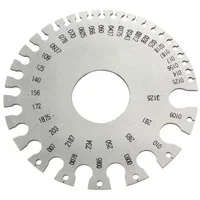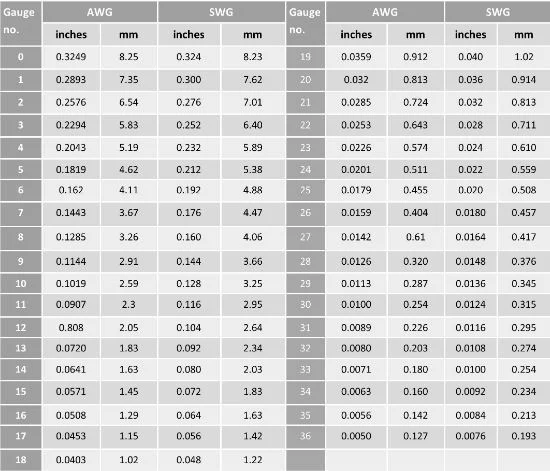In the field of metrology, i.e., the scientific study of measurement, wire gauges are used to measure the diameters or cross-sectional area of round, solid, nonferrous, electrically conducting wires. By utilizing the diameter or cross-sectional area of the wire, wire gauges assist users in knowing the current-carrying capacity of electrically conducting wires.
Wire gauge sizes not only determine how much current can safely be transmitted or passed through the wire, but the resistance of the wire along with its weight per unit of length, too. A wire’s gauge also indicates the thickness of the conductor that electrons flow through. For optimum transmission, a wire’s conductor must be increased in order to reduce resistance.
Wire Gauge Standards: AWG vs SWG vs IEC
 Wire gauge sizes are represented through numerical values, AWG 4/0 through AWG 40. The lower the number assigned to a wire the larger its diameter; the higher the number the smaller its diameter. AWG stands for American Wire Gauge. AWG is the numerical standard that established wire gauge sizes for measuring wire gauges in the United States. The AWG is not universal. The British Imperial Standard Wire Gauge, the SWG, is the standard of measurement used in the UK. More popular is the IEC 60228, the International Electrotechnical Commission’s international standard on conductors of insulated cables. IEC 60228 is the metric wire-size standard used throughout most parts of the world. Thus, because of the three different standards, how wire gauges are measured and what standard sizes of wire are the most obvious differences among the standard of measurements used throughout the world.
Wire gauge sizes are represented through numerical values, AWG 4/0 through AWG 40. The lower the number assigned to a wire the larger its diameter; the higher the number the smaller its diameter. AWG stands for American Wire Gauge. AWG is the numerical standard that established wire gauge sizes for measuring wire gauges in the United States. The AWG is not universal. The British Imperial Standard Wire Gauge, the SWG, is the standard of measurement used in the UK. More popular is the IEC 60228, the International Electrotechnical Commission’s international standard on conductors of insulated cables. IEC 60228 is the metric wire-size standard used throughout most parts of the world. Thus, because of the three different standards, how wire gauges are measured and what standard sizes of wire are the most obvious differences among the standard of measurements used throughout the world.
AWG standard for measuring wire is defined by the imperial system of measurement, the system that measures in inches. SWG and IEC measurements utilize metric systems. Comparative size charts shows drastic differences among the size measurements. The diameter of the electrical wires being measured is not interchangeable because the physical size of the wires differ. In addition, with SWG sizes, measurements in most cases are rounded up, and may affect the accuracy of the wire gauges.
What Wire Gauge Sizes Affect
Beyond international standards, another source of confusion is why wire gauge sizes appear to be backwards of what they should be—as the physical width of the gauge increases the numerical value assigned to it decreases. The explanation goes back to the original process of wire drawing. The number of times a wire is drawn and stretched relates to the numerical value given to the wire gauge. The drawing and stretching decreases the physical size of the wire making it longer and thinner. Wire drawing then, increases the gauge of a wire. In doing so it also reduces the current that can flow through the wire. Subsequently, the reduced current in larger gauged wires also decreases the amperage the wire can handle.

Wire gauge sizes are also used to calculate how much wire is necessary to conduct a signal or electricity. It’s especially important for engineers in working out the design of power systems. Determining wire gauge sizes along with type of wire material to use in any application or system translates into cost savings. System failures result when the wrong size gauges and/or materials are used.


